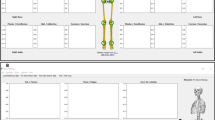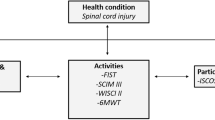Abstract
Objectives:
The purpose of this paper is to describe the development and evaluation of a new medial linkage reciprocating gait orthosis (MLRGO) that incorporates a reciprocal mechanism and is sensitive to pelvic motion to potentially assist paraplegic patients to walk and provide functional independence.
Case description and methods:
The new orthosis was constructed and tested by a 20-year-old female paraplegic subject with transverse myelitis at T10 level, who was 4 years post injury and had also been an isocentric reciprocating gait orthosis (IRGO) user for 2 years. She received gait training for 12 weeks before undertaking gait analysis, and also completed a questionnaire that was designed to assess the perceived functionality of the new MLRGO when compared with an IRGO.
Results:
The results demonstrated improvements in gait velocity, step length and cadence, and also improvement in functional independence with the new orthosis compared with an IRGO.
Conclusion:
The results demonstrated that this new MLRGO could be used for paraplegic patients who would like an improvement in functional independence and ambulation.
Similar content being viewed by others
Log in or create a free account to read this content
Gain free access to this article, as well as selected content from this journal and more on nature.com
or
References
Genda E, Oota K, Suzuki Y, Koyama K, Kasahara T . A new walking orthosis for paraplegics: hip and ankle linkage system. Prosthet Orthot Int 2004; 28: 69–74.
Middleton J, Fisher W, Davis GM, Smith RM . A medial linkage orthosis to assist ambulation after spinal cord injury. Prosthet Orthot Int 1998; 22: 258–264.
Saitoh E, Baba M, Sonoda S, Tomita Y, Suzuki M, Hayashi A . A new medial single hip joint for paraplegic walkers. Ueda S, Nakamura R, Ishigami S. The Eighth World Congress of International Rehabilitation Medicine Association. Monduzzi Editore: Bologna, Italy, 1997, pp 1299–1305.
Whittle M, Cochrane GM, Chase AP, Copping AV, Jefferson RJ, Staples DJ et al. A comparative trial of two walking systems for paralysed people. Paraplegia 1991; 29: 97.
Arazpour M, Bani MA, Hutchins SW . Reciprocal gait orthoses and powered gait orthoses for walking by spinal cord injury patients. Prosthet Orthot Int 2012; 37: 14–21.
Ahmadi Bani M, Arazpour M, Farahmand F, Mousavi ME, Hutchins SW . The efficiency of mechanical orthoses in affecting parameters associated with daily living in spinal cord injury patients: a literature review. Disabil Rehabil Assist Technol 2014, 1–8.
Kirtley C, McKay S . Total design of the “Walkabout”: a new paraplegic walking orthosis. Proceedings of the Seventh World Congress of ISPO 1992. ISPO: Chicago, Illinois, USA., June 28–July 3. ISPO p39 [Abstract].
Onogi K, Kondo I, Saitoh E, Kato M, Oyobe T . Comparison of the effects of sliding-type and hinge-type joints of knee-ankle-foot orthoses on temporal gait parameter in patients with paraplegia. Japn J Compr Rehabil Sci 2010; 1: 1–6.
Harvey L, Davis GM, Smith MB, Engel S . Energy expenditure during gait using the walkabout and isocentric reciprocal gait orthoses in persons with paraplegia. Arch Phys Med Rehabil 1998; 79: 945–949.
Harvey LA, Smith MB, Davis GM, Engel S . Functional outcomes attained by T9-12 paraplegic patients with the walkabout and the isocentric reciprocal gait orthoses. Arch Phys Med Rehabil 1997; 78: 706–711.
Middleton JW, Sinclair PJ, Smith RM, Davis GM . Postural control during stance in paraplegia: effects of medially linked versus unlinked knee-ankle-foot orthoses. Arch Phys Med Rehabil 1999; 80: 1558–1565.
Acknowledgements
We thank the Iran National Science Foundation for financial support (grant number 9040942) for this research.
Author information
Authors and Affiliations
Corresponding author
Ethics declarations
Competing interests
The authors declare no conflict of interest.
Rights and permissions
About this article
Cite this article
Ahmadi Bani, M., Arazpour, M., Farahmand, F. et al. The influence of new reciprocating link medial linkage orthosis on walking and independence in a spinal cord injury patient. Spinal Cord 53 (Suppl 1), S10–S12 (2015). https://doi.org/10.1038/sc.2014.196
Received:
Revised:
Accepted:
Published:
Issue date:
DOI: https://doi.org/10.1038/sc.2014.196
This article is cited by
-
The influence of new medial linkage orthosis on walking and independence in spinal cord injury patients: a pilot study
Spinal Cord Series and Cases (2016)
-
The influence of orthosis options on walking parameters in spinal cord-injured patients: a literature review
Spinal Cord (2016)
-
Comparison of new medial linkage reciprocating gait orthosis and isocentric reciprocating gait orthosis on energy consumption in paraplegic patients: a case series
Spinal Cord Series and Cases (2015)



